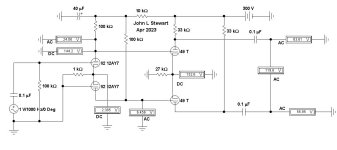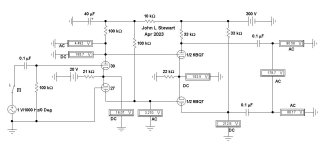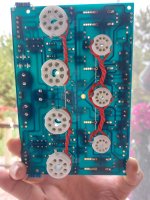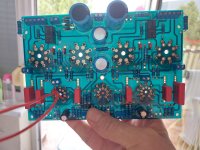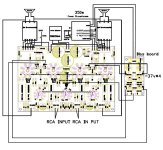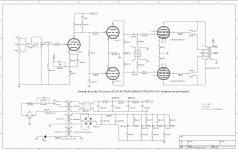FlaCharlie: All good. This has also been an exploratory thread for me, and I have learned much in the course of it, so I welcome the tangents brought by additional questions and their answers. Questions such as the interplay between the output impedance of the source, and the input impedance of a transformer placed at the input, are great to have answered. I am in the midst of building a 45/46 SET amp, will do a 300B SET next, and then will probably do the PP. I will hopefully decide on a circuit and post it here when I do. This discussion has had relevance for single ended amps as well. How about a one stage amp with a power tube fed by a high ratio input transformer. Is this possible? So many questions...
My first DIY project was the popular Bugle 45 SET that was designed by Gordon Rankin. It's one of two amps I use in my computer room, the other is a little Class D amp.I am in the midst of building a 45/46 SET amp, will do a 300B SET next, and then will probably do the PP. I will hopefully decide on a circuit and post it here when I do. This discussion has had relevance for single ended amps as well. How about a one stage amp with a power tube fed by a high ratio input transformer. Is this possible? So many questions...
I'm cheap so no 300Bs for me. My current project is a direct coupled SET which should have about the same power as a 300B. I'm using all DH tubes and the Hammond 1140-LN-C on the input, as suggested by Andy.
As for using an input transformer and output tube only . . . a while back I built a SE amp that runs 6BQ5s in pentode. It's a Voice of Music console amp that originally had a 6EU7 preamp tube on a different chassis that used an umbilical to connect it to the amp. I didn't have the preamp section and, of course, it had GNFB going back to the 6EU7. So I modded it so that it uses cathode feedback. The intent was to be able to use it with a variety of separate preamps.
Surprisingly, I discovered that it also works and sounds great with no preamp at all because the 6BQ5 is so easy to drive. Just the 6BQ5s running from the output of a DAC. It doesn't make as much power like that but it's quite usable. So, assuming there are no impedance matching issues, I'm sure that it would work fine with a step-up input transformer too.
I have had a quick look at the review in AudioScienceReview and that Loxjie DAC looks really good. It's the only one I have found.
However I would assume that the line output of 2V rms is measured with a typical preamp input load of 10K-100K? It doesn't specify. That would be useful to know because with its low Zout it should work as constant (output) voltage source but it has (output) current limitations too, as any device.
You can see this from the headphone output measurements: 175mW into 33R and 31mW into 300R. Looking closely at the distortion trend I would say that while 31mW into 300R is a pretty good reference, 90mW into 33R is a better limit to consider because 175mW is already onto the clipping side and it will take near nothing to result into nasty distortion. This means that the headphone output is capable of about 3Vrms into 300R and only 1.7Vrms into 33R.
In your place, I would use the headphone amp to drive the input transformer. In such case the 2.2K input of the 1140-LN-C should be fine even taking into account the capacitance of a 26 DHT driver stage and 3Vrms gives you more freedom for the power amp.
However I would assume that the line output of 2V rms is measured with a typical preamp input load of 10K-100K? It doesn't specify. That would be useful to know because with its low Zout it should work as constant (output) voltage source but it has (output) current limitations too, as any device.
You can see this from the headphone output measurements: 175mW into 33R and 31mW into 300R. Looking closely at the distortion trend I would say that while 31mW into 300R is a pretty good reference, 90mW into 33R is a better limit to consider because 175mW is already onto the clipping side and it will take near nothing to result into nasty distortion. This means that the headphone output is capable of about 3Vrms into 300R and only 1.7Vrms into 33R.
In your place, I would use the headphone amp to drive the input transformer. In such case the 2.2K input of the 1140-LN-C should be fine even taking into account the capacitance of a 26 DHT driver stage and 3Vrms gives you more freedom for the power amp.
I now have a request to build a PP amp, so I'll also have to solve the question of a circuit. I have a LL1660/18mA so I'll try that as a splitter after a single 2P29L. I'd also want to try a concertina splitter.
The ones in my line amp are ST-shape CV1166. There are no other markings on the valves. The white boxes they came in are marked 0621-5960-99-000-1166 VALVE, but I don’t suppose that’s much help. I have them mounted on Silentblocs. I run them conservatively at approximately 120 V on the anode with 4,5 V bias.If yours is usable in a line stage, I imagine it's constructed very differently from the sample I have.
If it's a CV1166, is there some other letters on the marking? Is it ST-shape?
My CV1166 was unused (NOS), but the microphony is too bad, even for a driver; a linestage would be impossible. I'll take a picture when I get a chance.
You can do that but the general solution is the same, i.e. first limit to what you can do and what you can't will be gain if you only have one voltage amp with mu=9. You can go for the full potato and also add an input transformer like the Hammond 1:4 for a fully transformer-coupled amp. This way you'll be able to use almost any triode strapped pentode. In fact, from what Ale found out, the 2P29L is quite capable if run close to its dissipation limit.I now have a request to build a PP amp, so I'll also have to solve the question of a circuit. I have a LL1660/18mA so I'll try that as a splitter after a single 2P29L. I'd also want to try a concertina splitter.
The 2P29L seems quite right for the LL1660 in all aspects. If you change for a concertina, gain will be the basically the same: the LL1660 is 2.25:2+2 which is what you get with a concertina, more or less, 1:0.9+0.9. The transformer will give you better handling of the power stage getting close to clipping. concertina will likely have lower distortion at high frequency (if it has enough anode current).
Last edited:
Yeah, I've been very pleased with the Loxjie D30. I just wish they had kept the original version in their lineup and added the version with MQA, which costs considerably more. I bought one when they came out and then another lightly used one later.I have had a quick look at the review in AudioScienceReview and that Loxjie DAC looks really good. It's the only one I have found. However I would assume that the line output of 2V rms is measured with a typical preamp input load of 10K-100K? It doesn't specify. That would be useful to know because with its low Zout it should work as constant (output) voltage source but it has (output) current limitations too, as any device.
In your place, I would use the headphone amp to drive the input transformer. In such case the 2.2K input of the 1140-LN-C should be fine even taking into account the capacitance of a 26 DHT driver stage and 3Vrms gives you more freedom for the power amp.
I've never tried using the headphone output for anything but perhaps I will sometime. For headphone use it's considered decent and quite usable but it's mostly the DAC that merits attention. When looking for the output impedance spec I came across another review which mentioned several other DACs that use the same chip. The only one that the reviewer preferred over the D30 cost $1500, compared to $160 for the Loxjie. Excellent bang for the buck.
The DAC can operate with a fixed output but the unit also has a preamp function which allows you to adjust the output. That's mostly how I use it.
For the subject of this thread there is an infinity less one possible circuits. Here are two for the pleasure & curiosity of the faithful, the lurkers & the newbies.
The first is based on 45’s rant in post #127 of this thread. Its not clear whether the 12AY7 is on the front end. But since it is mentioned first in his spec, that is where it appears in the Sim. Not sure if he still intends for there to be a transformer on the front end, so not in the spec, not in the Sim. For many the question of what mystical property the 49 brings to the party. It is simply another of a group of tubes that were developed in the 1930s for a way to significant audio with moderate B+ requirements. Normally three of these would be found in a Class B amplifier. Complete with much cross over distortion, in particular at low levels.
So letting my mind run freely here is one of several solutions that could easily drive PP 6CA7 / EL34s in triode mode. There seems no data on Miller capacity for the EL34 in triode. For the driver than this is dimensioned to satisfy PP 2A3s. And this cct does not need a transformer on the front end to achieve good balance. No transformer, no expense, no freq response worry.
What about the PS for this hookup? Many will have different solutions to cover this. If there is some interest beyond this post I’ll cover a way that does that in a slick way. 👍
The first is based on 45’s rant in post #127 of this thread. Its not clear whether the 12AY7 is on the front end. But since it is mentioned first in his spec, that is where it appears in the Sim. Not sure if he still intends for there to be a transformer on the front end, so not in the spec, not in the Sim. For many the question of what mystical property the 49 brings to the party. It is simply another of a group of tubes that were developed in the 1930s for a way to significant audio with moderate B+ requirements. Normally three of these would be found in a Class B amplifier. Complete with much cross over distortion, in particular at low levels.
So letting my mind run freely here is one of several solutions that could easily drive PP 6CA7 / EL34s in triode mode. There seems no data on Miller capacity for the EL34 in triode. For the driver than this is dimensioned to satisfy PP 2A3s. And this cct does not need a transformer on the front end to achieve good balance. No transformer, no expense, no freq response worry.
What about the PS for this hookup? Many will have different solutions to cover this. If there is some interest beyond this post I’ll cover a way that does that in a slick way. 👍
Attachments
@jhstewart9, your second solution with that odd input stage and the 6BQ7, I would never consider it. Not even under torture.
The circuit with 12AY7+49 should have the input transformer. Without input transformer I would do an LTP with CCS in the tail. The 49 doesn't have any mystical properties, it's just a very linear triode and is very usable for output swing up to 50+ Vrms. The trade-off is its low amplification factor.
And it's dual use: class A "standard triode" or Class B.
The circuit with 12AY7+49 should have the input transformer. Without input transformer I would do an LTP with CCS in the tail. The 49 doesn't have any mystical properties, it's just a very linear triode and is very usable for output swing up to 50+ Vrms. The trade-off is its low amplification factor.
And it's dual use: class A "standard triode" or Class B.
The only thing that doesn't look great about the headphone output is the noise at very low level. It gets better and better at higher level. It is better for the 300R case and from 50uW THD+N is already better than 80dB. That's just 122mV into 300R. It could get even better with 2.2K if follows the same trend from 33R to 300R. Worth trying, IMHO.I've never tried using the headphone output for anything but perhaps I will sometime. For headphone use it's considered decent and quite usable but it's mostly the DAC that merits attention. When looking for the output impedance spec I came across another review which mentioned several other DACs that use the same chip. The only one that the reviewer preferred over the D30 cost $1500, compared to $160 for the Loxjie. Excellent bang for the buck.
The preamp output I don't know if can drive such a low impedance transformer. The problem is not the output impedance but current capability.
boli46,
Your tube box was marked: 0621-5960-99-000-1166, Right?
. . . Welcome to the US Federal part numbering system.
I worked for the US military and US civilian jobs.
Now my only work for the US is paying taxes.
So I no longer have access to the books of Federal part numbers that list characteristic details . . . sorry.
Your tube box was marked: 0621-5960-99-000-1166, Right?
. . . Welcome to the US Federal part numbering system.
I worked for the US military and US civilian jobs.
Now my only work for the US is paying taxes.
So I no longer have access to the books of Federal part numbers that list characteristic details . . . sorry.
I have a CD player with XLR balanced outputs.
3V peak on 'each polarity's' outputs, 6V difference @ Full Scale DAC.
I could build a low power mono-block Balanced amplifier using a pair of EL84 tubes in either Ultra Linear Mode, or Pentode mode.
Can not get a much more direct signal path low distortion amplifier than that.
3V peak on 'each polarity's' outputs, 6V difference @ Full Scale DAC.
I could build a low power mono-block Balanced amplifier using a pair of EL84 tubes in either Ultra Linear Mode, or Pentode mode.
Can not get a much more direct signal path low distortion amplifier than that.
The dissimilar diffamp is nothing new at all. I & many others often used such a hookup in regulated power supplies,@jhstewart9, your second solution with that odd input stage and the 6BQ7, I would never consider it. Not even under torture.
The triode is connected to the reference, say a 5651 & the pentode used as the error amplifier. So no tortures & no pain, 👍
eddyvinyl,
An already built kit is ready to go, and should be working.
If you start a new thread . . .
Say if the amplifier is working or not.
Say if you want to modify it (get it working before modifying it).
Is the kit fully assembled, or are you trying to finish it?
I do not see a defined question in your posts, only a complaint about the seller;
There is no mention of the model make and number.
it is hard to respond to that.
An already built kit is ready to go, and should be working.
If you start a new thread . . .
Say if the amplifier is working or not.
Say if you want to modify it (get it working before modifying it).
Is the kit fully assembled, or are you trying to finish it?
I do not see a defined question in your posts, only a complaint about the seller;
There is no mention of the model make and number.
it is hard to respond to that.
I prefer a classic paraphase.The dissimilar diffamp is nothing new at all. I & many others often used such a hookup in regulated power supplies,
The triode is connected to the reference, say a 5651 & the pentode used as the error amplifier. So no tortures & no pain, 👍
- Home
- Amplifiers
- Tubes / Valves
- Schematic wanted for push-pull triode connected pentode amp with DHT front end
